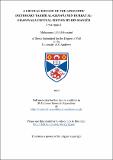Files in this item
A critical edition of the linguistic dictionary Tahḏīb Al-Khawāṣ Min Durrat Al-Ghawwāṣ a critical edition by Ibn Manẓūr, 711/1311
Item metadata
| dc.contributor.advisor | Burton, John | |
| dc.contributor.author | Al-Hussaini, Mohammad Ali | |
| dc.coverage.spatial | xi, 105, 333, 82, xxii | en_US |
| dc.date.accessioned | 2018-07-13T15:21:20Z | |
| dc.date.available | 2018-07-13T15:21:20Z | |
| dc.date.issued | 1979 | |
| dc.identifier.uri | https://hdl.handle.net/10023/15392 | |
| dc.description.abstract | After studying this linguistic dictionary in manuscript: Al-Tahḏīb by Ibn Manẓūr, I realised the importance of studying and editing the manuscript. This research on Tahḏīb and the development of lexical studies and linguistics led me to note the strong relationships between classical and modern studies especially in Arabic linguistics. Here we can follow the developments of texts and the ideas behind them, both in dictionaries of different schools and in general linguistic works, from the beginnings of the study of the Arabic language, tracing the influence of Arabic studies on that of some eastern and western languages in the mediaeval period. Arabic grammar was developed by treating problems in spoken language. People were in need of rules to help them acquire correct style, to be able to understand the meaning of Qur’ān and Ḥadīth. The scholars, whose work has influenced present-day Arab linguistics and grammatical theory, based their studies on Qur’ānic texts and quotations taken from early poetry. The method of study was generally inductive. Moving from the particular to the general, the scholars discussed various language phenomena in booklets and books concerned with texts, listing words which they had heard from Arabs employing their own local usages and dialects. These indexes became the data of the lexicons and linguistic books. From the first study of Arabic, the linguists dealt with Al-Laḥn, the phenomena affecting the pronunciation of Arabic, observing the errors in the speech of the ordinary people, of the educated people, and even of the scholars. Al-Durrah by Al-Ḥarīrī was one of the most famous works in Arabic linguistics. To treat the scholars' errors rather than those of the ordinary people, it follows no system or method in its structure. Ibn Manẓūr had to classify its lexical items and to arrange them on his Lisān Al-Arab system, with a special critical approach. Some books written before Al-Durrah had the same aim to note Al-Laḥn. In Al-Durrah we can follow the train of those books, which dealt with linguistic materials, especially Adab Al-Kātib by Ibn Qutaiba which we consider an ancient precursor of Al-Durrah and on the other hand of Al- Tahḏīb, the dictionary which we are here editing for the first time. | en_US |
| dc.language.iso | en | en_US |
| dc.publisher | University of St Andrews | en |
| dc.subject.lcc | PJ6620.M25T2H8 | |
| dc.subject.lcsh | Ibn Manẓūr, Muḥammad ibn Mukarram, 1232-1311 or 1312. Lisān al-ʻArab | en |
| dc.subject.lcsh | Arabic language--Dictionaries | en |
| dc.title | A critical edition of the linguistic dictionary Tahḏīb Al-Khawāṣ Min Durrat Al-Ghawwāṣ a critical edition by Ibn Manẓūr, 711/1311 | en_US |
| dc.type | Thesis | en_US |
| dc.contributor.sponsor | Iraq. Wizārat al-Taʻlīm al-ʻĀlī wa-al-Baḥth al-ʻIlmī | en_US |
| dc.type.qualificationlevel | Doctoral | en_US |
| dc.type.qualificationname | PhD Doctor of Philosophy | en_US |
| dc.publisher.institution | The University of St Andrews | en_US |
This item appears in the following Collection(s)
Items in the St Andrews Research Repository are protected by copyright, with all rights reserved, unless otherwise indicated.

